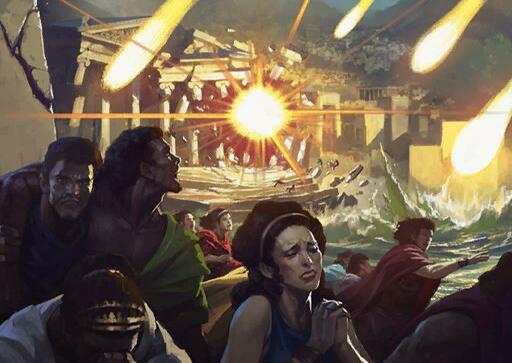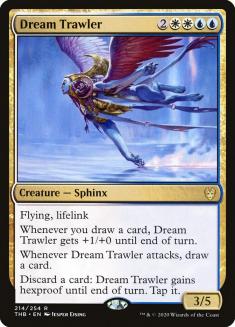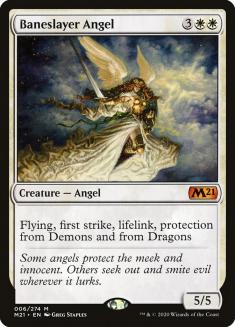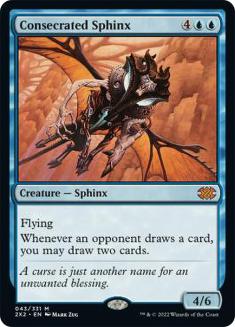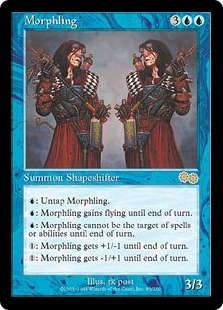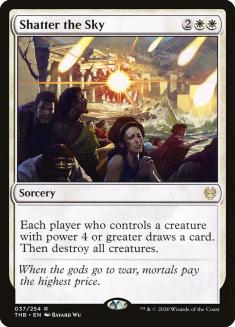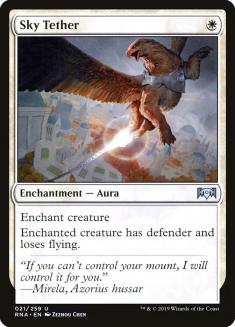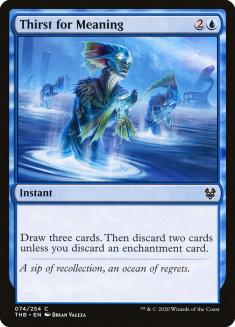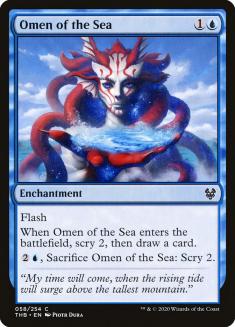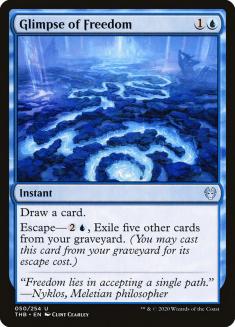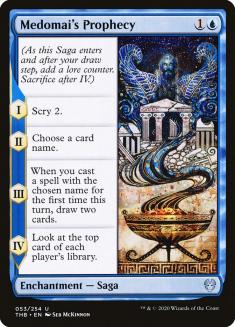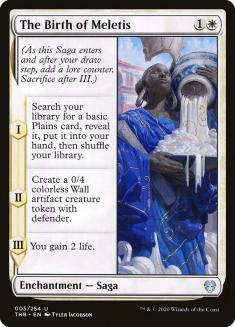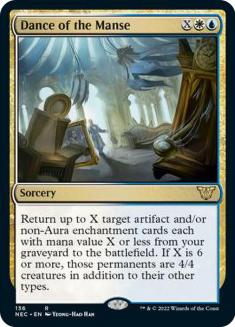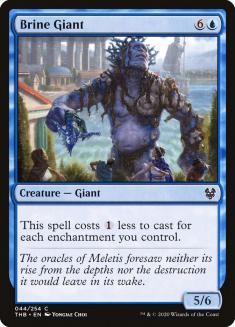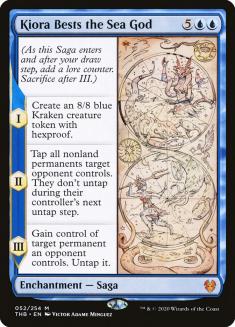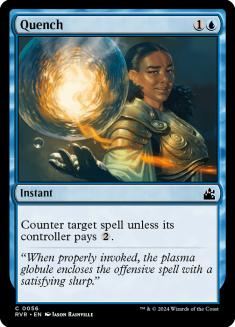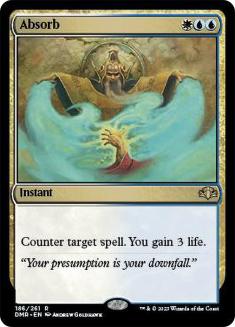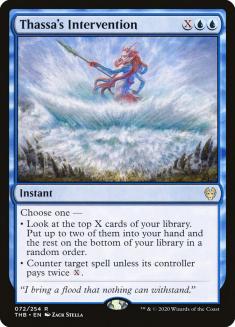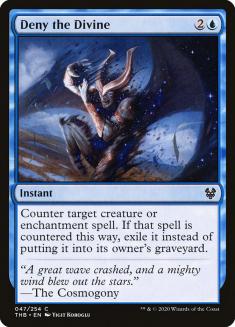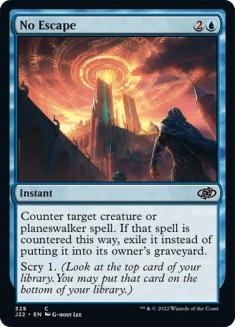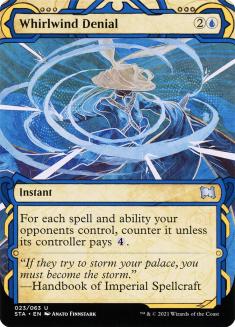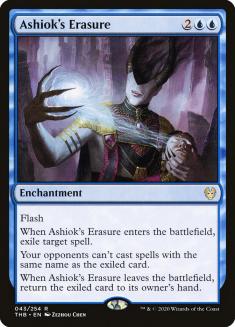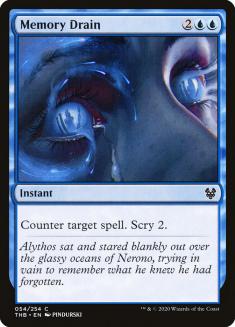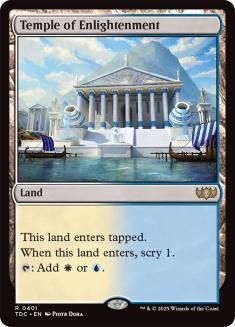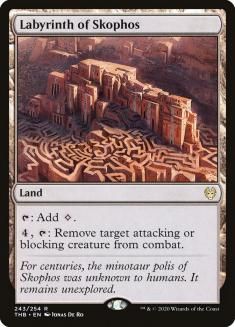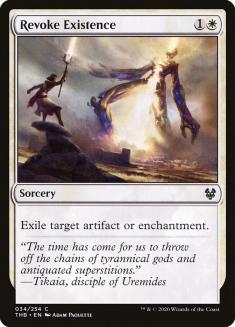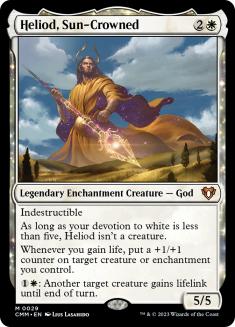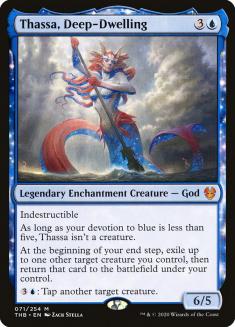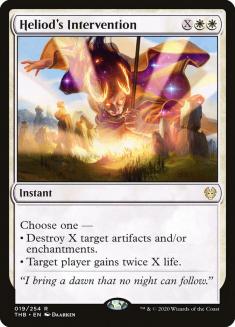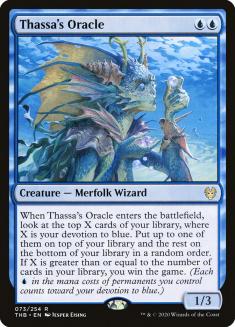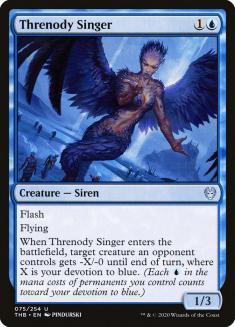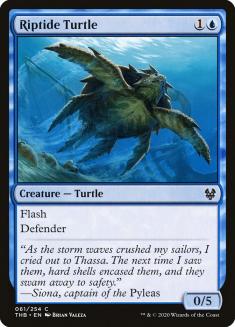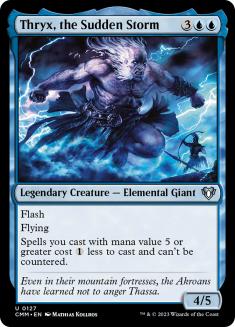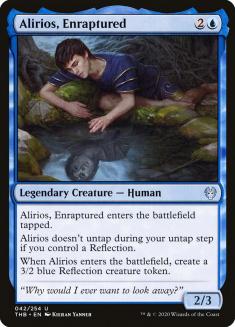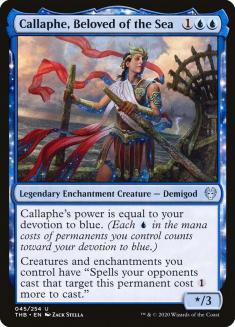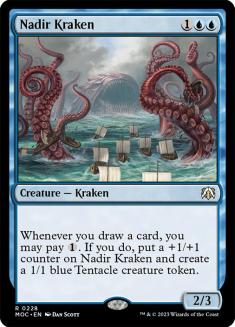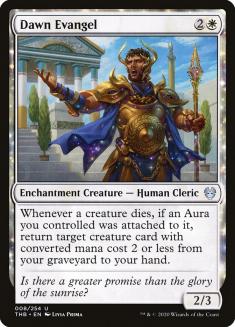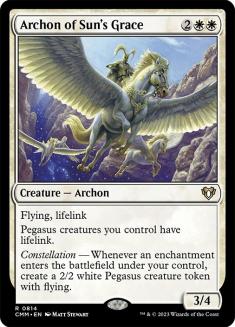I’m not saying Azorius Control is back…
…because who said it was ever gone?
Dream Trawler is a major new addition to the archetype, and sort of just the perfect blend of control finishers.
Seriously, this is one of my favorite designs of the set, and not (I don’t think, anyway) because it’s a sweet control finisher. Rather, I think it’s such an awesome blend of stuff you want for this style of a deck, and balanced in a way that looks really positive. I’d way rather the right answer for top-end plans be something like this than something like Finale of Revelation or Teferi, Hero of Dominaria, you know?
We get it. You like the control finisher. Why is this one actually good and not just appealing with rose-colored glasses?
Okay, let’s talk briefly about the different aspects of this card and then why the rate is actually quite strong.
- Baneslayer Angel: A major threat that can win the game on its own, can swing the direction combat is going the turn you play it, can get you out of jams, can protect you in a proactive manner, can give you advantages in areas you might not be long in despite stabilizing
- Consecrated Sphinx: A major threat that can take over the game on its own (and would also be such if it drew one card a turn), building advantage turn after turn which rewards you for playing defensive and interactive cards, a must-kill threat regardless of enemy strategy
- Morphling: A major threat that can be counted on to finish the job, gives you options, reliable, can play offense and defense, allows for tricky tactical play
If we start through the lens of Baneslayer Angel, a card that has seen a ton of play at lots of times, we’re talking about two primary advantages over it and two primary disadvantages compared to it.
First of all, Baneslayer Angel is a 5/5 with first strike (and protection from Demons and Dragons). By contrast, Dream Trawler is only a 3/5 on defense (at least at a baseline, with card draw changing things). This makes Baneslayer Angel a better blocker in general (though Dream Trawler is still quite good). On the other hand, Dream Trawler attacks as at least a 5/5 (with the potential to be much higher, without even trying very hard). Once you factor in the extra card you get for attacking, we’re talking about a much, much stronger ability than the first strike and two extra points of power on defense are worth.
Of course, Dream Trawler costs a mana more than Baneslayer, to say nothing of the blue requirements. Are we getting an extra mana worth? Well, if that was all there was to the card, it’d be a little tight and might not be enough to justify the full extra mana. However, we’ve got one more ability, and that’s the ability to pay zero and discard a card to give it hexproof, leaving it tapped (which if you’re already tapped or attacking doesn’t even matter).
This ability is awesome for helping shore up Baneslayer Angel and Consecrated Sphinx’s natural vulnerability to removal. I think people might initially underestimate how much the tapping part will really matter, but the ability is still clearly quite useful. I’m not sure how the format will shake out; but from a strictly rate perspective, this ability and the card draw seem worth more than a mana. It seems to me this is a stronger card than Baneslayer Angel, despite the six-cost.
Creatures (3)
Planeswalkers (4)
Lands (26)
Spells (27)

I think it’s going to be fine to play just one copy of Dream Trawler in some builds. There’s just value in diversity of gameplan for taking over the game, as well as in how we’re going to go about generating a game-winning advantage, so if we’ve got strong enough alternatives, we don’t need to necessarily be completely reliant on it.
Shatter the Sky is a really powerful new sweeper that might be so good that we should just max out on it (particularly when we don’t even have many creatures that let us take advantage of Time Wipe’s bounce ability super-well). Letting our opponent draw an extra card isn’t necessarily that big of a deal. Costing a mana less is such an advantage; and when we’re killing stuff with four or more power, we’re generally already doing pretty well.
There is a little bit of tension between Sky Tether and Shatter the Sky, in that Sky Tether can leave your opponent with a big creature on the battlefield that is at least a little bit of a liability when we go to sweep it away. It’s really not a big deal, however, and costing one is just so amazing compared to other alternatives.
Why isn’t this already a popular removal option, then?
Three words.
Sky Tether was just dead in too many matchups for super-wide adoption. Thirst for Meaning changes all that, giving us an excellent new tool for control decks with enough enchantments to support it. Anyone who has played Thirst for Knowledge will be able to attest to just how powerful this kind of effect is, and it’s particularly great when the card it asks you to trade for a draw-three is something that might be dead in a bunch of matchups.
Omen of the Sea looks excellent to me. Preordain is one of the best cards of all time; and for a mana more, we get an instant-speed version that also leaves us with a respectable option we can cash in later, when we’ve got extra mana. Scry 2 is generally worth about half a card, so compared to Think Twice, we’re getting 1.5 cards up front, and then the last 0.5 cards later, at our leisure. That’s way better than having the cards spread out, as it means we’re getting more of the advantage earlier and for cheaper.
On top of all of this, we even get enchantment synergies. Omen of the Sea would normally be a little clunky and might be a good candidate to shave some copies; however, once we’re playing Thirst for Meaning, we can put extra copies to great use.
Speaking of Think Twice…
Don’t let appearances fool you. Glimpse of Freedom is not even as good as Think Twice would be in Standard. I’m not saying it’s a zero, but this card has all the makings of a trap. First of all, you’ve got to exile five cards just to get up to Think Twice range, and you don’t actually get “ahead” until you’ve exiled ten cards and spent eight mana. Maybe it’s worth playing one of these instead of an Omen of the Sea, but they have greatly diminishing returns, and I’m just not sold on the quality of option in the first place. Obviously, the more self-mill, looting, or other effects that give us this option “for free,” the better it gets, but at least in the list above, I’m skeptical.
Another way to spend our second turn to smooth our draw and gain advantage, Medomai’s Prophecy has two fundamental problems in control. First, you can only cast it at sorcery speed, giving it a higher opportunity cost than other options. Second, in order to get the two cards, you’ve got to let your opponent know about one of your plays a turn ahead of schedule, and then that play needs to be during your turn. This is kind of the nail in the coffin, ensuring Medomai’s Prophecy is for a different style of deck, one that is okay with playing a very proactive (and likely enchantment-based) strategy.
As far as two-cost enchantments that generate an advantage at sorcery speed go, The Birth of Meletis looks like a better fit and I could easily imagine playing a couple of copies if we’re getting enough mileage out of the blocker.
All these enchantments that end up going to the graveyard, whether by completing their Saga or by sacrifice, all stack together to imply a new kind of Dance of the Manse deck. Thirst for Meaning discarding enchantments only furthers this gameplan. This is definitely going to be a strategy to watch for.
While there are a few enchantments here and could be more, Brine Giant would take a lot of enchantments to get us in the mood for. Notably, it is a Giant, which could be interesting with Realm-Cloaked Giant.
While there is some appeal to having one or more of our finishers be enchantments we can discard to Thirst for Meaning, I just don’t buy Kiora Bests the Sea God as a strong enough finisher in the above sort of deck. It’s not a bad card, and I think it’ll see play in decks that value it as an enchantment, but the blunt advantages it grants are not necessarily lined up as conveniently as we’d like (unlike Dream Trawler).
Look, I’m not saying I’m happy about it. Quench isn’t great, but we need some cheap plays. Essence Capture isn’t the easiest to cast, but maybe ends up good enough, I guess. There aren’t many options at two, and we’re already so long on threes.
I’m still really big on Absorb, and definitely want it over Sinister Sabotage. If we had room for another three-mana counterspell, I’d definitely be interested in trying a Thassa’s Intervention.
Thassa’s Intervention is kind of an interesting mix of three-mana permission and four-mana draw-two. Obviously, it continues to scale with more mana, but so much of the power is front-loaded in each half, it really is kind of a split card between those two abilities; they just also happen to have an X-spell kicker.
1UU – Counter target spell unless its caster pays 2. Multikicker 1: Increase this amount by 2.
Obviously, the three-cost version is way worse than we’d play, but it works just as well, when it works. It’ll also usually be able to get the job done later, if we need, whether for four or five.
2UU – Draw two cards. Multikicker 1: Scry 1.
Actually getting to look at that many cards at once is better than scrying a bunch, and in a pinch, you could cycle the card for 1UU. On the whole, however, this isn’t a bad way to look at this option. While neither option is unreal or anything, this does seem like it could be a good way to get a little of both, while also fitting another scaling design into our deck (which would be particularly attractive if we were playing Nyx Lotus or Nyxbloom Ancient or whatever).
The other three-mana counterspells of Theros Beyond Death aren’t super-attractive for such a deck. Deny the Divine is just much weaker and more narrow than the already mediocre but well-named No Escape (which I could actually imagine playing if Elspeth, Sun’s Nemesis or the Titans end up major players).
Whirlwind Denial could obviously be of use if there’s some reason we end up needing to be able to counter activated abilities, or they happen to reprint storm in the next year.
You laugh, but this could actually be Chekhov’s gun. Why would they show us the gun in Act I if it wasn’t going to get fired by Act III? Maybe they’re just filling out the set with cards that have some purpose in more powerful formats, but this one isn’t really strong enough to do much in that department.
The new four-mana permission spells don’t bring much to the table for this strategy, either. Ashiok’s Erasure could at least have purpose, on account of its ability to stop uncounterable spells and escape cards (and that’s to say nothing of possible enchantment synergies). I realize the above deck has some enchantment synergies, but we’ve just got so much better of stuff to do for four or more mana.
Memory Drain is just weak. We’re already not playing Sinister Sabotage, and surveil is slightly stronger than scry. Scry 2 is definitely not worth a full mana more than scry 1. When you think about how much stronger Counterspell is than Dissolve, that’s at least how much stronger Dissolve is than Memory Drain (and really, the higher the cost, the greater the opportunity cost of additional increases in mana, on the average, which is to say nothing of every higher scry amount tends to be worth less per scry than the amount less than it — i.e. scry 2 is not worth double scry 1).
As for other interaction in the deck, there’s kind of an interesting question with regards to which nonbasics we can play and how many. Castle Vantress and Castle Ardenvale are both fine options, and maybe we’re supposed to play more, but the printing of Temple of Enlightenment does sort of reduce how free they are.
Our colored requirements were already easy, and the Temples only reduce how hard it will be to cast our spells, so maybe we’re supposed to play more lands like Labyrinth of Skophos. The tension comes from how much they don’t play nicely with Absorb or the Castles. That’s not a big cost, though, and I’d kind of be inclined to try two rather than zero. Field of Ruin is also a totally reasonable option in some amount.
Eternal Isolation isn’t necessarily so good that it needs to be played. It’s just too narrow to be universally needed. It is quite cost-efficient, though, and the ability to tuck the creature to the bottom of their deck is an excellent option for fighting indestructible and escape.
Likewise, Revoke Existence is a great option for giving us artifact / enchantment protection that is specifically good against Gods, like Heliod and Thassa.
Incidentally, while I think Heliod and Thassa are both strong in the right decks, I don’t think they’re appropriate for a control deck like the above. They both just interact so well with creatures and to really take advantage of them, you’re going to want to have a fair number of them.
Heliod’s Intervention looks pretty nice to me, and I could totally be talked into playing one maindeck. The ability to destroy multiple artifacts and enchantments is awesome, and the super-scaling lifegain ability is generally at least useful against most everyone without artifacts and enchantments (and sometimes amazing).
Interested in the card, no question, and it’s a giant wild card that may prove substantially stronger than meets the eye. I could imagine, a month from now, it just being obvious that every white deck should have three or four, or whatever. At the moment, however, the card looks better to me in white aggro that goes a little bigger and in token-based strategies. Still, definitely want to try it here, just in case it proves to add enough dimensions. In general, however, we’re not short on ways to dominate a long game.
While I think this card is going to be a major player in some decks, I don’t think it’s close to good enough as a straight-up value card. You’ve got to either be deep on devotion to blue or aiming to run yourself out of cards.
Again, only worth it if we’re blue devotion. That said, I do want to call out just how much stronger than one is than other comparable designs that have generally been 1/2s, rather than 1/3s.
While there have been times where I could imagine playing this card as an early defensive card, we’ve got plenty of better options these days.
I’m kind of into this card, but more in some kind of Simic Flash deck or in blue devotion deck with lots of Agent of Treachery action. It wouldn’t be unthinkable to see this in Azorius Control, but it’s not nearly as on-plan as some other options.
If we’re willing to go down the path of playing actual creatures, there are lots of really interesting options. If you start going down this path, however, you’re probably going to want to go pretty far. The most notable possible exception, I suppose, is Archon of Sun’s Grace. I could easily see maindecking it in the list above, as well as possibly building an even more enchantment-focused version making heavy use of it.
Whether it’s just a slight modification to the above or moving towards an actual tap-out control deck, Archon of Sun’s Grace looks really strong to me and possibly one of the defining cards of the format.
Creatures (5)
Planeswalkers (4)
Lands (25)
Spells (26)


